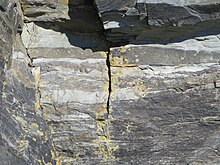| Treptichnus Temporal range: 542–99.7 Ma PreꞒ Ꞓ O S D C P T J K Pg N | |
|---|---|

| |
| Burrows viewed from the side | |

| |
| Burrows viewed obliquely | |
| Trace fossil classification | |
| Ichnogenus: | †Treptichnus Miller, 1889 |
| Ichnospecies | |
| |
| Synonyms | |
| |
Treptichnus (formerly named Phycodes, Manykodes by J. Dzik, and also known as Trichophycus) is the preserved burrow of an animal. As such, it is regarded as the earliest widespread complex trace fossil. Its earliest appearance, around 542 million years ago (mya), which was contemporaneous with the last of the Ediacaran biota, is used to help define the dividing line, considered geologically at 541 mya, between the Ediacaran and Cambrian periods. It is last seen in the fossil record during the Cenomanian (99.7 mya).
Description

Treptichnus pedum has a fairly complicated and distinctive burrow pattern: along a central, sometimes sinuous or looping burrow it made successive probes upward through the sediment in search of nutrients, generating a trace pattern reminiscent of a fan or twisted rope. The organism that left such traces is considered more complex than earlier Ediacaran biota; and these trace fossils, which occur worldwide, are usually found in strata above those.
Since only its burrows have been found, it is presumed that the Treptichnus animal lacked any hard anatomical features, such as shells or bones. Its morphology and relationship to modern animals is therefore unknown, and some dispute even its inclusion within the animal kingdom. Despite this lack of fossil evidence, surface trails produced by modern priapulid worms exhibit the same probing morphology as Treptichnus, suggesting a close anatomical relationship between the trace-maker and modern priapulids.
Etymology
The name Treptichnus pedum means "turned trail (Greek) of feet (Latin)".
References
- ^ AK Rindsberg and DC Kopaska-Merkel. 2005. Treptichnus and Arenicolites from the Steven C. Minkin Paleozoic Footprint Site (Langsettian, Alabama, USA). Alabama Paleontological Society Monograph 1 : 121-141
- ^ DZIK, Jerzy (2005). "Behavioral and anatomical unity of the earliest burrowing animals and the cause of the "Cambrian explosion"" (PDF). Paleobiology. 31 (3): 503–521. doi:10.1666/0094-8373(2005)031[0503:BAAUOT]2.0.CO;2. S2CID 55910646.
- ^ See e.g. fossiilid.info: paleodiversity in Baltoscandia: Trichophycus pedum
- Srivastava, Purnima (June 2012). "Treptichnus pedum: An Ichnofossil Representing Ediacaran - Cambrian Boundary in the Nagaur Group, the Marwar Supergroup, Rajasthan, India" (PDF). Proc. Indian Natl. Sci. Acad. 78 (2): 161–169. Retrieved April 8, 2016.
- Subcommission on Neoproterozoic Stratigraphy - URL retrieved June 22, 2009
- International Commission on Stratigraphy, International Chronostratigraphic Chart, 2012, http://www.stratigraphy.org/column.php?id=Chart/Time%20Scale
- McMenamin, Mark A.; Dianna L. McMenamin (1990) . The Emergence of Animals. Columbia University Press. ISBN 0-231-06647-3.
- "Life in the Cambrian". Archived from the original on 2006-02-20. Retrieved 2006-03-09.
- Altermann, Wladyslaw (2002) . Precambrian Sedimentary Environments. Blackwell Publishing. ISBN 0-632-06415-3.
- Vannier, J.; Calandra, I.; Gaillard, C.; Zylinska, A. (2010). "Priapulid worms: Pioneer horizontal burrowers at the Precambrian-Cambrian boundary". Geology. 38 (8): 711–714. Bibcode:2010Geo....38..711V. doi:10.1130/G30829.1.
| Taxon identifiers | |
|---|---|
| Treptichnus | |
This trace fossil-related article is a stub. You can help Misplaced Pages by expanding it. |